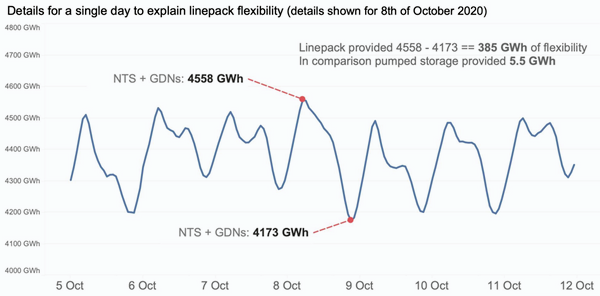Our energy system is changing. We are connecting more and more renewables and there will be increasing electrification, with pressures put on the electricity system as a result. The gas system will likely be used in a different way to which it is used today to accommodate this.
Much of the debate centres around how we are going to connect even more renewable energy to the system, encourage customers to adopt low carbon technologies and manage bills as a result. But it is critical that attention is given to how we store energy and use it flexibly in a much more variable energy system. We can’t control the wind, and we can’t control the sun, which means we will need an energy system which is capable of storing significant amounts of energy.
The role of linepack
In today’s energy system, the gas network provides much of the storage and flexibility needed to keep our lights on and homes warm. One of the primary ways it does this is through a function called ‘linepack’.
Linepack is the term used to describe the amount of gas contained within the higher-pressure pipelines (>7bar) of Britain’s transmission and distribution gas infrastructure. Linepack delivers an unrivalled degree of energy system flexibility, with the gas system filled up with gas overnight and then those volumes used during the period of higher demand across the following day. The graph below illustrates how this plays out in practice.

This flexibility is particularly valuable during the winter ‘heating season’, when the hourly demand for gas can be over four times that of electricity. Linepack is being used more for power generation too, with gas-fired power generation forming a gradually smaller part of the overall electricity generation mix but increasingly being relied upon to ramp up and down quickly to provide crucial electricity system flexibility.
It is hard to overstate the vast energy storage capacity that exists in the pipes running under our feet. Research from the UK Energy Research Centre calculates annual linepack flexibility to be in the region of 100TWh per year[1], against the backdrop of around 700TWh of annual gas demand (thanks to Grant Wilson for allowing me to share his fantastic work on this). To put this into context, matching the annual storage capability offered by linepack is equivalent to filling and emptying by far our largest gas storage facility, Rough, six and a half times.
Equating these numbers in electricity system terms puts the value of linepack in even clearer context. 100TWh of flexibility is equivalent to using the full capacity of our largest pumped hydro facility, Dinorwig in North Wales, 11,000 times. Equally, you would need to fully charge and discharge 2 billion average electric vehicles or a staggering 7.5 billion Tesla Powerwalls to match the annual energy storage capability of the gas network.
However, we know we cannot continue to use the gas network to transport fossil fuels if we are to meet Net Zero. So, how can we replicate the valuable flexibility we get from linepack as the energy system evolves?
The future energy system will need diverse sources of storage – and a lot of it
Replacing the linepack value of the natural gas system is not impossible, but it will present considerable challenges. For example, while there is no technical reason that linepack can’t be delivered using hydrogen, the lower energy density of hydrogen compared to methane means that the linepack potential of the same volume of gas is lower[2].
Replacing the flexibility value of linepack in today’s gas network will require us to take a whole systems approach, utilising both the electricity and gas systems. The Royal Society estimated that the UK will need up to 100TWh of low carbon storage capacity by 2050 to manage periods of low renewable generation[3]. We can get some of this from flexibility on the electricity supply side, through technologies such as batteries, pumped hydro or compressed air energy storage, for example. But these tend to store energy for hours rather than weeks, months or seasons, and not to the scale the system is going to need. On the demand side, we should utilise the flexibility capabilities of technologies like electric vehicles and heat pumps, while also looking to unlock flexibility from consumers through demand-side response. This will help, and will also help to manage the costs of the energy transition, but the reality is that we won’t get anywhere near the storage and flexibility needs of the future energy system without green gas in some form.
We are going to need significant amounts of green gas storage infrastructure, through dedicated storage facilities, pipelines, or, more likely, both, storing a mixture of green gases including biomethane and hydrogen. Exactly how those gases are used is another question, but there is no pathway for the future of the energy system which does not involve significant amounts of green gas storage and flexibility.
As the country moves towards Net Zero, we must be mindful that the challenge is not all about connecting up renewable generation and adopting low carbon technologies. We also need to design and deliver an energy system which is resilient, keeping our energy supplies secure during even the most challenging system conditions. Replicating the linepack value of today’s gas system with diverse sources of energy storage will be absolutely fundamental to getting this right.
Sources:
[1] UK Energy Research Centre (2019)
[2] Linepack potential of hydrogen innovation project led by National Gas
[3] Royal Society (2023)
